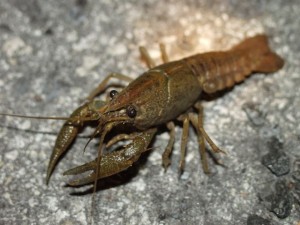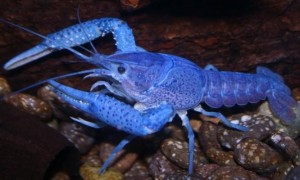
Many ornamental and natural pond owners will at some point look to add some sort of critter to their pond for some added interest or for another reason like algae and aquatic weed control. One of the options that they are sure to see out in the pond market would be crayfish. Crayfish for your pond (Procambarus sp.); also called crawfish, crawdaddys, mudbugs, are pretty commonly offered by pond center retailers. To be sure, crayfish can add interest and a bit of plant and/or algae control to your pond.
Crayfish look like little lobsters, sporting very large front claws much like the Maine Lobster. Also like the Maine Lobster, it is native to the U.S. Crayfish have hard shells that they will molt from time to  time. This molting, interestingly, will often occur when the moon is in its full phase. Crawdaddys “gotbout” 10 legs, easily seen when they swim. They can swim forward and backward using powerful thrusts of their tail to propel them. Those 2 large claws are used to defend, fight, and capture; they are very strong and can give a real nice pinch so be careful handling them. The exoskeleton covers the entire body except for the underside, and is usually a shade of brown and red but also a blue variety popular in the aquarium trade; called “electric blue” crayfish (which are pretty cool!). Crayfish have 2 antennae and eyes on the outside of their head.
time. This molting, interestingly, will often occur when the moon is in its full phase. Crawdaddys “gotbout” 10 legs, easily seen when they swim. They can swim forward and backward using powerful thrusts of their tail to propel them. Those 2 large claws are used to defend, fight, and capture; they are very strong and can give a real nice pinch so be careful handling them. The exoskeleton covers the entire body except for the underside, and is usually a shade of brown and red but also a blue variety popular in the aquarium trade; called “electric blue” crayfish (which are pretty cool!). Crayfish have 2 antennae and eyes on the outside of their head.
Crayfish can regenerate lost limbs. They have strong jaws that they will use to eat the shell that they molt. The female crayfish will carry eggs on her abdomen, and baby crayfish will hold onto the mother for a time before they drop off to be on their own. Crayfish have gills to extract oxygen from water, but can also survive extended periods out of the water; sometimes making pretty long overland journeys. In the southern US crayfish, or crawfish as they are called in the south, are grown on crawfish farms and harvested in May, June, and November. They are a very popular regional cuisine prepared in flavorful “boils” and very tasty; eaten like shrimp or tiny lobsters. The new comer to this cuisine may be surprised when they are told to “suck the head”! But let’s not eat any crayfish from our backyard ponds, ok? Crawfish are readily available from the farms, and we should leave it to the pros to provide us with edible crawdaddys!
When purchasing cra yfish for your pond you should know that they are generally sold as “crayfish” but there are actually several varieties available. The varieties are difficult to tell apart, and need to be looked at very closely by someone who knows crayfish pretty well; and that typically is not going to happen. One variety (species) Procambarus fallix virginalis, reproduces by cloning itself. Ponds that have very high crayfish populations probably have the “virgin crayfish” variety; and those populations’ numbers can get very high, so they will need to be thinned from time to time. The annual spring cleanout for your pond is a good time to remove the overpopulation.
yfish for your pond you should know that they are generally sold as “crayfish” but there are actually several varieties available. The varieties are difficult to tell apart, and need to be looked at very closely by someone who knows crayfish pretty well; and that typically is not going to happen. One variety (species) Procambarus fallix virginalis, reproduces by cloning itself. Ponds that have very high crayfish populations probably have the “virgin crayfish” variety; and those populations’ numbers can get very high, so they will need to be thinned from time to time. The annual spring cleanout for your pond is a good time to remove the overpopulation.
Crayfish are very hardy and can handle a very wide range of water quality and temperature extremes pretty well. They are filter feeders and scavengers with a diet ranging from snails and small fish, to plants, algae, and other crayfish! They will also easily accept any prepared foods you offer too. Crayfish are shy and not very visible in the pond and will generally hide during the day, get active at dusk. In natural ponds they will burrow into the mud banks or an area around the pond during winter; while in liner or concrete style ponds they will settle into leaf piles, plants, silt pockets, or wherever available. If you are intentionally keeping crayfish, offer them somewhere to winter over.
The benefits of keeping crayfish is that they are easy to keep and have a very minor effect in the control of algae and aquatic weeds, they help create a more complete ecosystem in your pond, they are very fun to have because you don’t see them that often, and they can offer some recreation in a natural pond by fishing them. In natural ponds they also offer a natural source of food for game fish and aquatic birds. Keep an ear open for the next crawfish festival where you can learn how to enjoy them in a whole different way!! And remember….SUCK THE HEAD!!
All copyrights to this material is solely owned by Mike Gannon.

how can i get some crayfish for my pond? thanx sp
Hi Steve, many pond centers will carry cray fish or even online fish dealers. If no luck with them try googling a biological supply house, they typically have these type of critters! Thanks for checking out the blog!! -Mike
I have 200 acres in Northwest Alabama just below the Tennessee River near a little town called Town Creek, Alabama.
My question is, how far north geographically is acceptable to raise crawfish?
Hey Tommy, thanks for the question. Are you raising them as a food item, or for pleasure? If it is for a food item I’d recommend checking with other authorities in your area regarding livestock farming, if it is for pleasure I think you are just fine! Good luck! -Mike
im looking for live brown crawfish that build mud towers for sale I tried looking up pond suppy and biological but did not have any luck please help as I want them for my garden before bad weather comes thanking you in advance katherine
Hello Katherine, I can recommend trying a Louisiana crawfish supplier. Apart from those type of suppliers I do not have a great source for crayfish. Good luck! -Mike Gannon
I have a 1200 gal pond in the backyard. How many crawdads can I put in the pond? I found about 40 in the canal.
Id only suggest adding a few crawdads at the maximum. They will take over your pond otherwise!! Mike
Crayfish breed like crazy! I started with just 3. They pretty much took over my 1500 gallon pond and for the past two years I’ve been using traps to remove them. I’ve taken out over 150. A pond can only sustain so many living things.
Hey Todd, thanks for putting that out there. Those who successfully keep crayfish might have to be careful of them reproducing too successfully! -Mike
well i’m starting with 4. have a 2000 gallon pond and the goldfish have done a good job of reproducing so decided to add a few crawfish to maybe keep the fish in check. have a trap to get the crawfish when they get to be too many. have taken out 20 goldfish this year. will definately keep an eye on the crawfish also. Thanks for all the info everyone.
Good luck Doneva! Check back with some results please! -Mike
I have a 90 acre fresh water spring fed lake that is 21 ft. deep on one end and tapers to 1 ft. deep on the other end. Has bass, perch, cat, minnows and sun fish plus frogs, located central west N.J. I would like to introduce cray fish to the mix, what do you recommend. Do you have any thoughts on trout or who i can contact, has no streams and the bottom is mostly sand, gravel and any fallen trees and leaves. thank you Don
For crayfish I always say go to the source in Louisiani where there are lots of crayfish! Good luck!! -Mike
Hi Mike,
I have a 3500 gallon Koi pond with plastic liner. Will crayfish damage the liner?
Hello Ben. Crayfish can potentially damage liners, it may not happen however it is not unheard of. Crayfish breed in ponds so 20 may not seem like much now but in a few years you may have lots of them!! Good luck. Mike
Hi Mike,
I have a 3500 gallon Koi pond with plastic liner. Will crayfish damage the liner? Are 20 crayfish too many for my pond?
Hey Mike,
I have a spring fed stream with an abandoned beaver pond. The water temperature stays at 38 -40 degrees year round. Is there a crayfish that could live in these temps? If so where could I purchase them from. Thanks, Stan
Hello Stan. Yes crayfish could handle those temperatures. Reach out to a crayfish breeder and have them ship some crayfish right to your door! Good luck! -Mike
I have a question my daughter got a crayfish as pet from a friend. I have Koi fish can they live in the same environment without the crayfish attacking the Koi fish
Hello Shakeera. Thanks for checking out the blog. Although they can do ok together, they are not the best tank mates and I would not suggest it. Good luck! -Mike
I have a question about crayfish. I live on the eastern shore of Maryland and was surprised to find crayfish in an excavation I dug to pour a footer foundation that periodically fills with water. Each time I drain it I find crayfish. Where are they coming from? The Pocomoke River is about a thousand yards away.
Hello Willie. Thanks for reaching out. Oddly enough I just had same conversation with a client regarding crayfish in the landscape. It seem that crayfish will create burrows quite a distance from natural or obvious water sources. I experienced the same thing in my suburban New Jersey backyard, when after one of the hurricanes that blew through, I found numerous crayfish in my yard. It may seem hard to believe until you experience it like yourself. The main source is likely the river, but they are obviously colonizing your area. Enjoy!